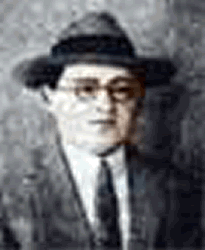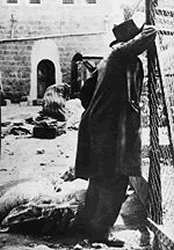Meshulam Shraga Fybl Mitevski ( 1903- 1929)

Meshulam was the son of Ben Zion, the Rabbi of Lebadove, who was killed in 1905 when Meshulam was only 2 years old. The father was well known and wroth Bnai Zion.
Meshulam came to Eretz Israel and was a student of the Hebron Yeshiva. He was killed in the 1929 massacre
http://en.wikipedia.org/wiki/1929_Hebron_massacre
Slabodka yeshiva , also known as Knesses Yisroel, and later as Hebron Yeshiva or Yeshivas Hevron....A 1924 edict requiring enlistment in the military or supplementary secular studies in the yeshiva led a large number of its students to relocate to Hebron under Rabbi Finkel's leadership, and the yeshiva was then headed by Rabbi Finkels' son in law; Rabbi Yitzchok Isaac Sher. Hebron was chosen over Jerusalem to avoid the influence of the conservative old yishuv.
All officials in the Hebron civil administration were Arabs. Of its 40 policemen, only one was a Jew. Raymond Cafferata, the Assistant District Superintendent of the Palestine Police Force, had at his command 18 mounted policemen and 15 on foot, of whom 11 were elderly men in poor physical condition. On the early afternoon of Friday, August 23, upon hearing from car-drivers of fighting in Jerusalem, Cafferata deployed special pickets to report any unusual movement from the city and issued a request to headquarters for reinforcements. Intending to travel to Jerusalem, a crowd of 700 gathered at the city's central bus station, and one man gave a speech. Cafferata addressed the crowd, trying to calm them by denying anything happened in Jerusalem. He then took eight mounted officers to patrol the Jewish homes, where he encountered the city's Rabbi, Yaakov Yosef Slonim. The Rabbi pleaded with him for protection, while he came under a hail of stones from an Arab crowd. Cafferata told him and other Jews he came across to return to stay in their homes. After the Rabbi had obliged, Cafferata tried to disperse the crowd using clubs. [2]
At 4:00 pm, an Arab crowd began gathering outside the Hebron Yeshiva and throwing stones through the windows. Only two people were inside, a student and the sexton. Upon being hit, the student tried to leave to find himself facing the Arab crowd, who grabbed him and stabbed him to death; the sexton survived by hiding in a well. Some hours later a group of mukhtars came to Cafferata. Cafferata attempted to get the mukhtars to assume responsibility for law and order, and asked for reinforcements. Some hours later a group of regional mukhtars came to Cafferata, and they relayed that the Mufti had told them to take action or be fined due to the 'Jewish slaughter of Arabs' in Jerusalem. Raymond Cafferata promised that all was well and bid them return to their villages and stay there. He slept in his office that night. [2]
Early the following Saturday morning, a crowd armed with staves and axes appeared in the streets and killed two Jewish boys, one stoned to death and the other stabbed. Cafferata shot two of the mob and emptied his revolver into the crowd, but his saddle slipped and he fell to the ground, whereupon the crowd began attacking every Jewish house. Cafferata instructed his men to fetch rifles and to open fire, which they did, dispersing a portion of the crowd, but some of the remaining rioters, shouting "on to the Ghetto", managed to break through the pickets. Cafferata continued shooting, hitting many of the rioters, but his efforts were in vain; repeated calls for reinforcements from Jerusalem, Jaffa and Gaza did not produce help in time. Both Jewish and Arab businesses in the Bazaar were looted. [4] A consignment of police was sent from Jerusalem but was delayed by other violence on the way to Hebron and arrived hours too late. This later became the source of considerable acrimony. [2]
A man reflecting on the aftermath of the pogrom
Cafferata testified to the Commission of Enquiry in Jerusalem on 7 November that he had seen an Arab cutting a child's head with an axe. Behind him was an ex-police-constable standing over a woman with a dagger in his hand. Cafferata shot the assailant, who shouted "Your Honor, I am a policeman". The Times reported Cafferata's evidence to the Commission that "until the arrival of British police it was impossible to do more than keep the living Jews in the hospital safe and the streets clear [because he] was the only British officer or man in Hebron, a town of 20,000". [5]
Many Jews survived by hiding in their Arab neighbors' houses, while others survived by taking refuge in the British police station at Beit Romano on the outskirts of the city. The surviving Jews were later evacuated to Jerusalem. One third of the killed were students of the Hebron yeshiva. After the massacre, the remainder of the yeshiva was also moved to Jerusalem. [2]
